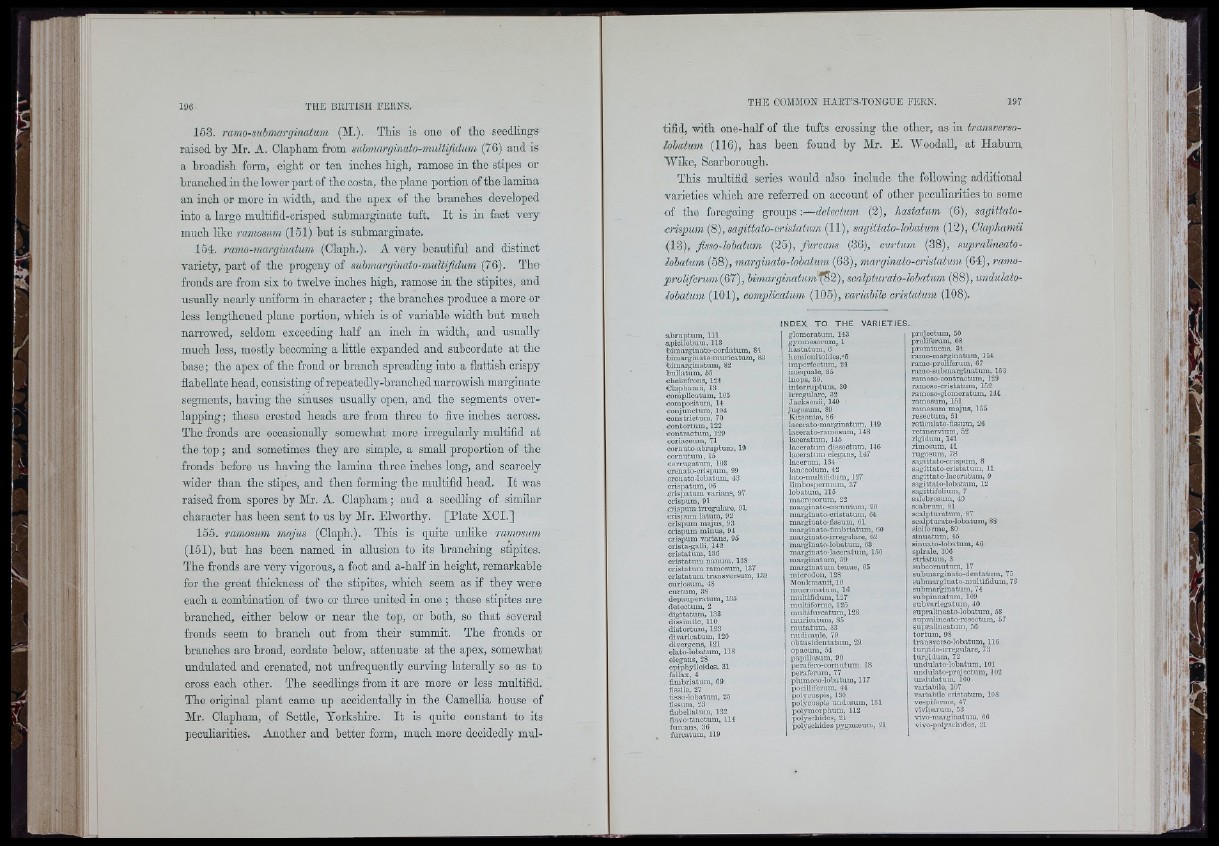
153. ramo-submarginatum (M-). This is one of tho seedlings
raised by Air. A. Clapham from submarginato-multifidum (76) and is
a broadish form, eight or ten inches high, ramose in the stipes or
hranohod in the lower part of the oosta, the plane portion of tho lamina
an inch or more in width, and the apex of the branches developed
into a largo multifid-orisped suhmarginate tuft. It is in fact very
much like ramosum (151) hut is suhmarginate.
154. ramo-marginatum (Claph.). A very beautiful and distinct
variety, part of the progeny of submarginato-multifidum (76). The
fronds are from six to twelve inches high, ramose in the stipites, and
usually neai’ly uniform in character; the branches produce a more or
less lengthened plane portion, which is of variable width but much
narrowed, seldom exceeding half an inch in width, and usually
much less, mostly boooming a little expanded and subcordate at the
base; tho apex of the frond or branch spreading into a flattish crispy
flabellate head, consisting of repeatedly-branched narrowish marginate
segments, having the sinuses usually open, and the segments overlapping
; these crested heads are from three to five inches across.
The fronds are occasionally somewhat more ii-regularly multifid at
the top ; and sometimes they are simple, a small proportion of the
fronds before us having the lamina three inches long, and scarcely
wider than the stipes, and then forming the multifid head. It was
raised from spores by Air. A. Clapham; and a seedling of similar
character has been sent to us by Air. Elworthy. [Plate XCI.]
155. ramosum majus (Claph.). This is quite unlilie ramosum
(151), but has been named in allusion to its branching stipites.
The fronds are very vigorous, a foot and a-half in height, remarkable
for the great thickness of the stipites, which seem as if they were
each a combination of two or three united in one ; these stipites are
branched, either below or near the top, or both, so that several
fronds seem to branch out from their summit. The fi-onds or
branches are broad, cordate below, attenuate at the apex, somewhat
undulated and crenated, not unfrequently curving laterally so as to
cross each other. The seedlings from it are more or less multifid.
The original plant came up accidentally in the CameUia house of
Air. Clapham, of Settle, Yorkshire. It is quite constant to its
peculiarities. Another and better form, much more decidedly mul-
' ir
tifid, with one-half of the tufts crossing the other, as in transverso-
lobatum (116), has been found by Air. E. AVoodall, at Haburn
AVike, Scarborough.
This multifid series would also include the following additional
varieties which are referred on account of other peculiarities to some
of the foregoing groups :—detoctum (2), hastatum (6), sagittato-
crispum (8), sagittato-cristatum (11), sagittato-lohatum (12), Claphamii
(13), fisso-lohatum (25), furcam (36), curtum (38), supralineato-
lobatum (58), marginato-lobatum (63), marginato-cristatum (64), ramo-
proliferumifil), bimarginatum^2), scalpturato-lohatum (88), undulato-
lobatum (101), compUcatum (105), variabile cristatum (108).
abruptum, 111
apicilobum, 113
bimarginato-cordatum, 84
bimarginato-muricatum, S3
bimarginatum, 82
bullatum, 55
cbeliefrons, 124
Claphamii, 13
complicatum, 105
compositum, 14
conjunctum, 104
constrictum, 70
contortum, 122
contractum, 129
coriaceum, 71
cornuto-abruptum, 19
cornutum, 15
corrugatum, 103
crenato-crispum, 99
crenato-lobatum, 43
crispatum, 96
crispatum varians, 97
crispum, 91
crispum iiTCgulare, 91
crispum latum, 92
crispum majus, 93
crispum m inus, 94
crispum varians, 95
crista-galli, 142
cristatum, 136
cristatum nanum, 138
cristatum ramosum, 137
cristatum trausversum, 139
curiosum, 48
curtum, 38
depauperatum, 135
detectura, 2
digitatum, 133
dissimile, 110
distortum, 123
divaricatum, 120
divergens, 121
elato-lobatum, 118
elegans, 28
epiphylloides, 31
fallax, 4
fimbriatum, 69
fissile, 27
fisso-lobatum, 25
fissum, 23
flabellatum, 132
fiavo-tiiietum, 114
fuvcans, 36
furcatum, 119
NDEX TO TH E VARIETIES
glomcratura, 143
gymuosorum, 1
hastatum, 6
bemiouitoides,'5
imperfectum, 24
inæquale, 35
inops, 39.
interruptum, 30
irreguläre, 32
Jacksonii, 140
jugosum, 89
Kitsouiæ, 86
lacerato-marginatum, 149
lacerato-ramosum, 148
laceratum, 145
laceratum dissectum, 146
laceratum elegans, 147
lacerum, 134
lanceolum, 42
lato-multifidum, 127
limbospermum, 37
lobatum, 115
macrosorum, 22
marginato-corautum, 20
marginato-cristatum, 64
mai'ginato-fissum, 61
marginato-fimbriatum, 60
margiuato-irregulare, 62
marginato-lobatum, 63
marginato-laceratum, 150
marginatum, 59
marginatum tenue, 65
microdon. 128
Monkmanii, 10
mucronatum, 16
multifidum, 127
multiforme, 125
multifurcatum, 126
muricatum, 85
mutatum, ¿3
nudicaule, 79
obtusidentatum, 29
opacum, 54
papillosum, 90
perafero-cornutum. 18
peraferum, 77
plumoso-lobatum, 117
pocillifemm, 44
polycuspis, 130
polycuspis uudosum, 131
polymoi’phum, 112
polyschides, 2L
polyschides pygmæum, 21
projectum, 50
proliferum, 68
prominens, 34
ramo-marginatum, 154
ramo-proliferum, 67
ramo-submarginatum, 153
ramoso-coutractum, 129
ramoso-eristatum, 152
ramoso-glomeratum, 144
ramosum, 151
ramosum majus, 155
resectum, 51
reticulato-fissum, 26
retinervium, 52
rigidum, 141
rimosum, 41
rugosum, 78
sagittato-crispum, 8
sagittato-cristatum, 11
sagittato-laeeratum, 9
sagittato-lobatum, 12
sagittifolium, 7
salebrosum, 49
scabrum, 81
scalpturatum, 87
scalpturato-lobatum, 88
sieiforme, 80
sinuatum, 45
sinuato-lobatum, 46
spirale, 106
striatum, 3
subcornutum, 17
submarginato-dentatum, 75
submarginato-multifidum, 76
submarginatum, 74
subpiuuatura, 109
subvariegatum, 40
supralineato-lobatum, 58
supralineato-resectum, 57
supralineatum, 56
tortum, 98
transverso-lobatum, 116
turgido-irregulare, 73
tiu'gidum, 72
unduiato-lobatum, 101
undulato-projectum, 102
undulatum, 100
variahile, 107
variabile cristatum, 108
vespiforme, 47
viviparum, 53
vivo-marginatum, 66
vivo-poiyschides, 21
■JI
«-M'hi'l I
‘ ì ' t l
Mi
-', ij,
h 'Î
Ili
r i i
li?'
liil
ri
r i
l ì rii